

Guiding Principles for Use of Technology with Early Learners. The thoughtful use of technology by parents and early educators can engage children in key skills such as play, self-expression, and computational thinking which will support later success across all academic disciplines and help maintain young children’s natural curiosity. The Departments recognize that families and early educators have many different options for using technology with early learners. The Departments believe that guidance needs to reflect the reality that families and early educators have access to apps, digital books, games, video chatting software, and a multitude of other interactive technologies that can be used with young children. Even as new technologies emerge, the Departments believe that these principles apply, though guidance may evolve as more research on this topic is published. Whole Child Development Is Undervalued.
The question is how to make such an approach both systemic and sustainable. Whole Person Socio-emotional, physical, creative, and cognitive capacities are deeply intertwined and equally important in ensuring a child's wellbeing, learning, and growth. (That shouldn't be a surprise to anyone studying or supporting children's learning.) Nobel laureate James Heckman, a professor of economics at the University of Chicago, has shown that the non-cognitive skills emerging in early childhood are among the strongest predictors of adult outcomes. And Paul Tough, author of How Children Succeed, has continued to emphasize the crucial role that soft skills play in character formation and building on persistence, curiosity, and even grit -- the "passion and perseverance for very long-term goals," according to psychologist Angela Lee Duckworth.
Whole Child Development Is Undervalued. Short stories for kids. How to teach children English using illustrated storybooks. What makes illustrated storybooks such a good resource for teaching young learners of English? The British Council’s Gail Ellis, co-author of a storytelling handbook for primary English language teachers, explains.
Listen to an interview with Gail in our podcast and register for her webinar taking place on Thursday, 2 October. Illustrated storybooks provide an ideal resource for helping children learn English. This is because children love listening to stories. The Art of Control. Executive function — our ability to remember and use what we know, defeat our unproductive impulses, and switch gears and adjust to new demands — is increasingly understood as a key element not just of learning but of lifelong success. Researchers at the Center on the Developing Child at Harvard University describe executive function as an air traffic control system for the mind — helping us manage streams of information, revise plans, stay organized, filter out distractions, cope with stress, and make healthy decisions.
How to help your child learn English with YouTube videos. Tracey Chapelton, education consultant and materials writer, has some advice for parents of young English learners, whose home language might not be English. Practical tips. By Opal Dunn, educational consultant and author Introduction Young children learn English differently from most adults.

Most have an innate ability to pick up English while taking part in activities, by making sense of what they are doing and picking up the adult’s language that accompanies the activity. You can find out more in the British Council booklet ‘How young children learn English as another language’, also available on the parents pages of the LearnEnglish Kids website. Planned English sessions You can plan regular sessions which will usually take place: Ten ways to support your child’s English-learning at home. As the British Council opens a new Learning Time with Shaun & Timmy centre in Mexico for two- to six-year-olds, senior teacher Sarah Reid offers some useful tips for supporting your child’s learning at home.
More and more parents want their children to learn English from a young age. I often meet parents of children as young as two or three who say that proficiency in speaking English will help their child 'get ahead in a globalised world'. In other words, the sooner their children get started, the better. The single most important factor in a child’s success with English is their parents' interest and encouragement, no matter what their child’s age. So what can parents do at home to support their learning? 1. Sound Words: Examples of Onomatopoeia. Onomatopoeia is a fun, linguistic tool used in literature, songs and advertisements.
Now that you've seen examples of the individual words, consider the following examples of onomatopoeia words in use. Take a look at the different onomatopoeia examples in Todd Rundgren's song, appropriately named Onomatopoeia. Singing and Language Development. You know those gurgles and screeches your baby started making early on?
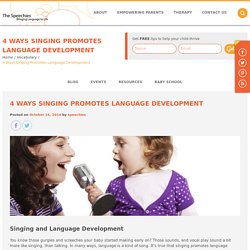
Those sounds, and vocal play sound a bit more like singing, than talking. In many ways, language is a kind of song. It’s true that singing promotes language development in the budding brain. Singing to your baby can help develop early language and literacy skills, such as auditory discrimination, phonological awareness, vocabulary development, and auditory memory. Auditory Discrimination Babies’ brains are wired to learn language. Carol Dweck: The power of believing that you can improve. How can parents and teachers best educate young children?
Listening Skills for Staff. Singing and Language Development. Labelling kids: the good, the bad and the ADHD. “ADHD”, “disruptive”, “behavioural difficulties”: labels like these are applied daily to our children.

But there is a growing concern amongst educators, parents and pupils that the use of such labels has the potential to damage young lives. What’s in a label? The labels we use to categorise children can be medical, such as “ADHD” (Attention deficit hyperactivity disorder) and “ODD” (Oppositional defiant disorder). They can be administrative, like “social, emotional and behavioural difficulties”, and they can be informal (“challenging” or “disruptive”).
Labels like these are used in our education system to categorise children according to their academic ability, educational needs and behaviour. Debates about the existence of disorders such as ADHD are ongoing. The Power (and Peril) of Praising Your Kids. What do we make of a boy like Thomas?

Thomas (his middle name) is a fifth-grader at the highly competitive P.S. 334, the Anderson School on West 84th. Slim as they get, Thomas recently had his long sandy-blond hair cut short to look like the new James Bond (he took a photo of Daniel Craig to the barber). Unlike Bond, he prefers a uniform of cargo pants and a T-shirt emblazoned with a photo of one of his heroes: Frank Zappa. Thomas hangs out with five friends from the Anderson School. They are “the smart kids.” Schema and Fairies. Schemas are one of those things that divide practitioners, like fairies at the bottom of the garden. "I Said I Want the Red Bowl!" Responding to… Amelia, told that she can’t have a fifth book before bedtime, shouts: “You are the meanest mommy!
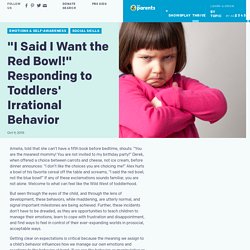
You are not invited to my birthday party!” Derek, when offered a choice between carrots and cheese, not ice cream, before dinner announces: “I don’t like the choices you are choicing me!” Alex hurls a bowl of his favorite cereal off the table and screams, “I said the red bowl, not the blue bowl!” If any of these exclamations sounds familiar, you are not alone.
Welcome to what can feel like the Wild West of toddlerhood. Does my toddler have a short attention span because she won’t sit still for a story? A: It is perfectly normal for toddlers to not sit still very long—period.
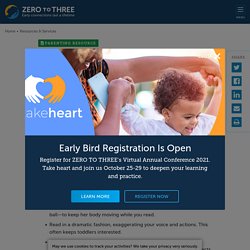
Most don’t like to stay in one place for long now that they can explore in so many new ways—by running, jumping, and climbing. So, an adult’s idea of snuggling on the couch to hear a story may not be the same idea a toddler has for story-time. You may only be able to read or talk about a few pages in a book at a time. Here are some ways to engage active children in reading: Read a book at snack times when your child may be more likely to sit for longer.Offer your child a small toy to hold in her hand—such as a squishy ball—to keep her body moving while you read.Read in a dramatic fashion, exaggerating your voice and actions.
What is play based learning. Children learn so much through play.

5 ways to win over parents to the importance of play in international EYFS. "I’m not sending my child to school for them play all day.
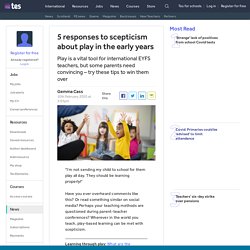
Deconstructing Role Play – Provide the Resources, Step Back and Watch Children’s Learning Flourish. Deconstructing Role Play – Provide the Resources, Step Back and Watch Children’s Learning Flourish. Convention on the Rights of the Child. Arabic | Chinese | French | Russian | Spanish Text in PDF Format. Let’s Do It Again . . . and Again! Why is Repetition Important to Learning? - Nemours Reading BrightStart!
“Repetition is the mother of learning, the father of action, which makes it the architect of accomplishment.”

(Zig Ziglar) Think back to when you learned to ride a bike, drive a car or play a new sport. First, you needed to learn the essential skills. Then it was all about practice and more practice until you increased your confidence, improved your speed and became skilled. Young Children and Infants Read to By Parents Have Stronger Vocabulary Skills. Rutgers-led study says shared reading advances these skills in nearly all children.
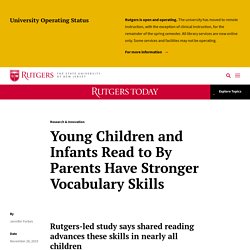
Teachers TV- How Do They Do It In Sweden? Helping schools, pre-schools and colleges. 6 Types of Play: How Children's Play Becomes More Social. Play is a serious business. The pioneering developmental psychologist Lev Vygotsky thought that, in the preschool years, play is the leading source of development. Through play children learn and practice many basic social skills. Getting the right balance between adult-led and child-initiated learning. As an early years practitioner you will know the importance of creating the right balance between adult-led and child-initiated learning. Help all children learn and develop with this guide. Heuristic play.
Heuristic play is rooted in young children’s natural curiosity. Welcome to week 2 - English in Early Childhood - British Council.